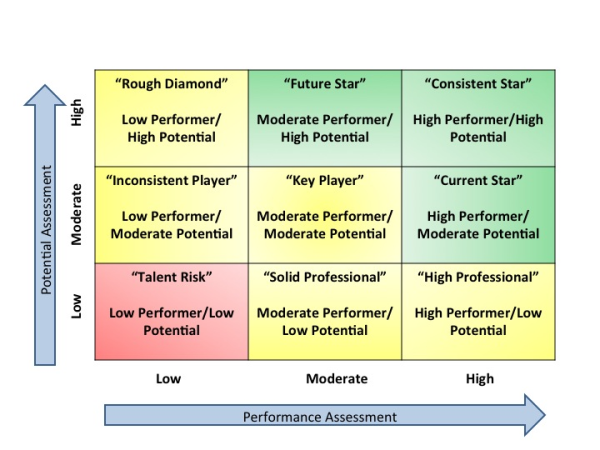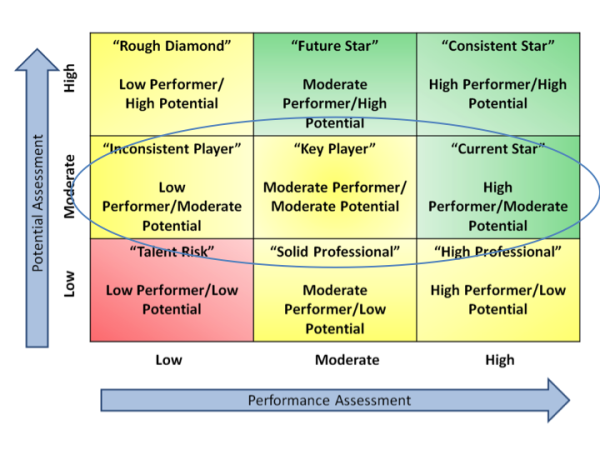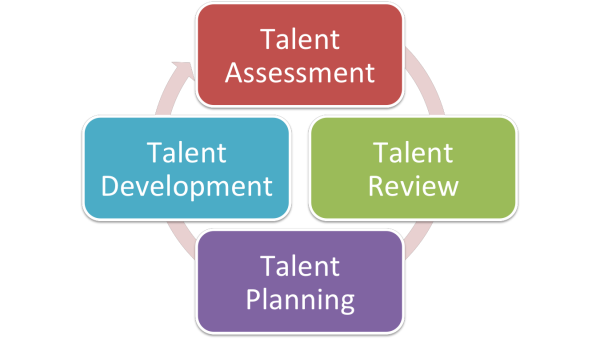Identifying and Removing Blockers Using the 9 Box Grid
What is a Blocker?
 A blocker is an employee who is preventing or “blocking” others from moving into a key position. Key positions serve as critical steps in a career path or offer a unique set of developmental experiences required for other roles in the organization. Companies should seek to fill key positions with high performing, high potential employees. We use the term blocker to describe individuals who are performing at or above expectations in a key position however they do not want to move out of the role for a variety of reasons. The individual may enjoy the role, may not have a desire to work additional hours or relocate, or do not have an interest in learning new skills and taking on additional responsibilities. The lack of desire to take on a new role or move to a new position limits their future potential, as well as the potential of others in the organization.
A blocker is an employee who is preventing or “blocking” others from moving into a key position. Key positions serve as critical steps in a career path or offer a unique set of developmental experiences required for other roles in the organization. Companies should seek to fill key positions with high performing, high potential employees. We use the term blocker to describe individuals who are performing at or above expectations in a key position however they do not want to move out of the role for a variety of reasons. The individual may enjoy the role, may not have a desire to work additional hours or relocate, or do not have an interest in learning new skills and taking on additional responsibilities. The lack of desire to take on a new role or move to a new position limits their future potential, as well as the potential of others in the organization.
Organizations should take steps to identify blockers during the succession planning or talent review process. Using the 9 box grid as illistrated below, we can explore the various scenarios in which Blockers are identified and determine actions plans to “unblock” key positions.

High Performers Without High Potential
Not all high performers demonstrate high potential, as illustrated in the 9 box example above. In some cases, individuals who fall into the categories of Current Star (High Performer/Moderate Potential) or High Professional (High Performer/Low Potential) are not necessarily a problem in the talent pipeline. However, the position that they occupy must be considered. If they hold a key position that would allow others to develop key skills and experiences, then they block individuals with high potential from gaining the full benefits of the key position.
High performing blockers can pose a great challenge for organizations as they provide a high level of experience and value. Organizations should approach these situations with a coaching mindset and have a dialogue that surfaces these individual’s interests and preferences. Be open and candid with the individual about how their current position offers a unique opportunity for others who seek broader responsibility. While it may be difficult to find a role to place these Blockers that will also meet all of their needs and expectations, open discussion may yield a variety of options that can be explored.
Moderate/Average Performers
Average performers holding key positions prevent the organization from gaining the most impact from the position. Ultimately, the organization should fill the key position with someone who can perform at a very high level. In the case of a Future Star (Moderate Performer/High Potential) we should take a developmental approach aimed at accelerating the individual’s performance. If the individual truly has the ability to take on more challenge, they will likely be able to bring their performance up to a higher level. You can find more information in the 3 part blog series I wrote on tailoring development plans based upon the 9 box. Click here for part 1 - Development at the Top - Use the 9 Box to Develop Talent in Succession Planning.
Organizations face the greatest challenge with blockers in the Key Player (Moderate Performer/Moderate Potential) and Solid Professional (Moderate Performer/Low Potential) category. Individuals in these groups are meeting organizational expectations but unfortunately occupy pivotal roles. Initiating career discussions is an important first step in determining a plan of action in these individual cases. Leaders should surface the individual’s career plans, interests and preferences, and discuss the potential of other positions that may align with their strengths. When potential positions are identified for Blockers, companies will want to make the transfer to a new role (i.e., streamlined internal interviews, preservation of benefits/salary, etc.) as seamless as possible so as to ensure continued performance and engagement.
Are Low Performers Blockers?
The distinction between a blocker and a low performer holding a key position is an important one to make. Key positions typically become occupied with low performers when individuals who have held those positions have failed to develop as the position or organization has changed. As such, companies are reluctant to remove them as they may have been strong contributors at one time and have long tenure. When low performers get in the way of promotional opportunities for others, the plan for removing them from their positions should be clear. We need to take all necessary steps to confront poor performance through feedback and developmental action plans. As in any scenario involving low performance, when low performance does not improve then termination should be considered as a potential option. Allowing low performers to stay, especially in key positions, sends a strong message that high performance is not valued within the organization. Read more in The Ultimate Plan for Tackling Poor Performance.
viaPeople has created a toolkit to help company's create a 9 box grid to support their unique talent review and succession planning process. Download the toolkit today and learn more about how viaPeople's Succession Planning and Performance Management solutions can help you manage talent your way!
Share this
You May Also Like
These Related Stories

Developing Future Promise - Use the 9 Box to Develop Talent in Succession Planning

Development at the Top - Use the 9 Box to Develop Talent in Succession Planning



